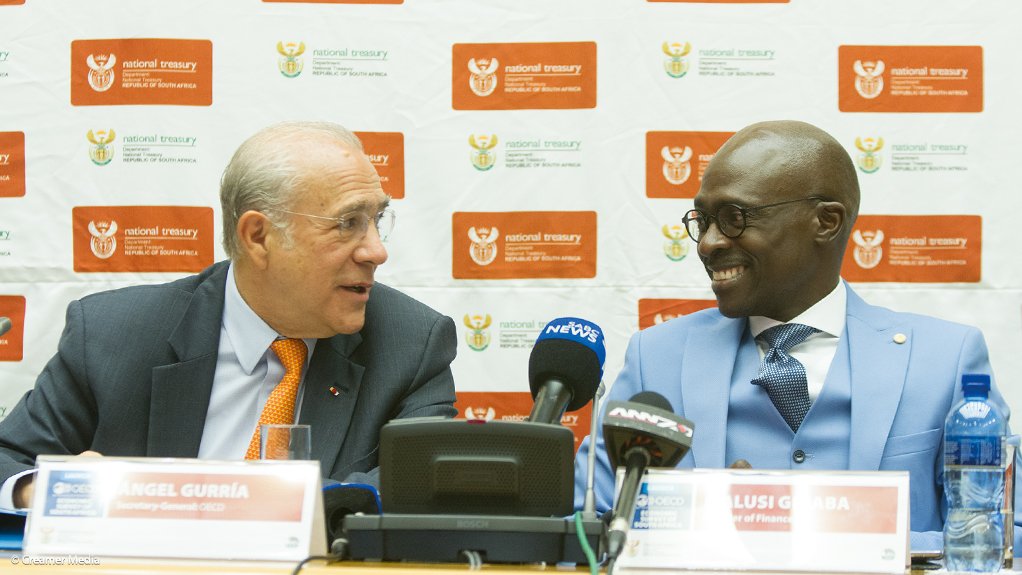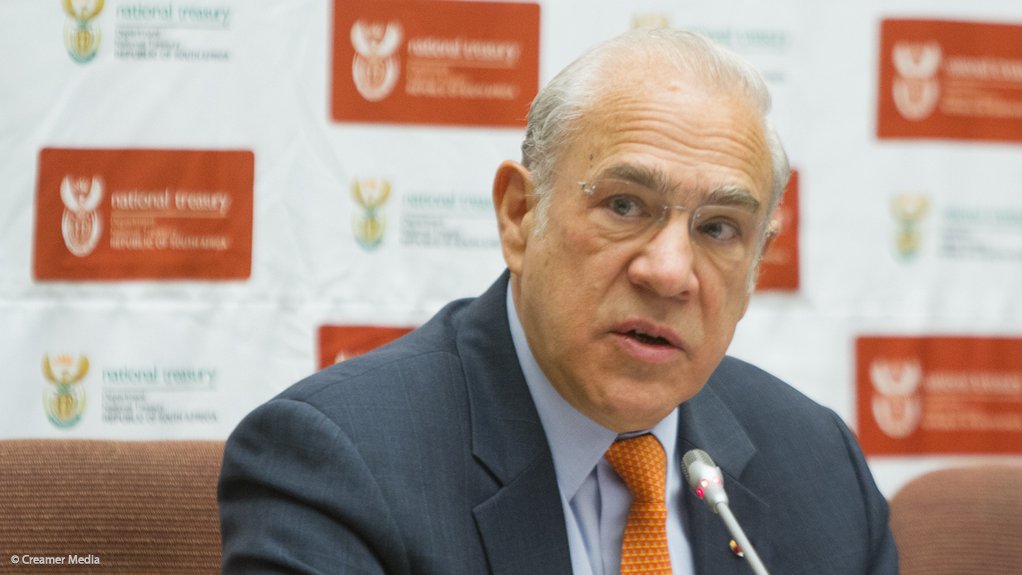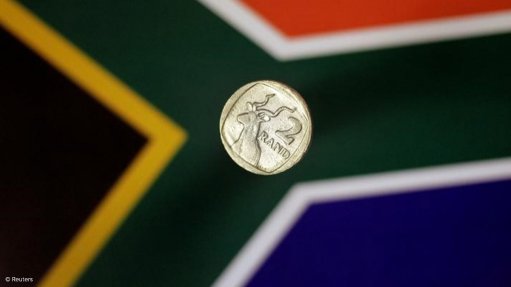South Africa’s ‘accelerating’ SOE-guarantee exposure a risk to debt sustainability



OECD secretary-general Angel Gurría and South Africa's Finance Minister Malusi Gigaba
Photo by Duane Daws
OECD secretary-general Angel Gurría
Photo by Duane Daws
Rising contingent liabilities in State-owned enterprises (SOEs), together with the recent ratings downgrades pose the main risks to South Africa’s debt sustainability, the Organisation for Economic Cooperation and Development (OECD) cautions in its fifth and latest economic survey of the country.
OECD secretary-general Angel Gurría described South Africa’s public-debt profile as “manageable”, despite a sharp increase to 51% of gross domestic product (GDP) from below 45% five years ago. However, when presenting the 2017 survey to Finance Minister Malusi Gigaba in Pretoria on Monday, Gurría strongly advised against allowing South Africa’s debt to increase further, particularly in the context of an increase in interest payments to above 3.5% of GDP and a rise in debt-service costs to around 10% of the yearly Budget.
Further downgrades, the survey states, may trigger spikes in interest rates and depreciation of the currency with persistent effects on growth and debt.
“I come from Mexico and, like South Africa, we have less room for mistakes, less room to manoeuvre and less room for complex signals to the markets – we need to give very clear, very strong signals to the markets. So, the fact that you are at 50% makes it manageable, but there is a large portion of interests payments and, therefore, we need to be prudent by limiting public debt and maintaining the confidence of financial markets,” Gurría, who previously played the roles of finance and foreign affairs secretary in Mexico, asserted.
The OECD also highlighted government’s “accelerating” exposure to SoEs through the issuance of guarantees to entities such as Eskom and South African Airways (SAA). Government’s exposure, measured by the total amount of borrowing and accrued interests made against the guarantees, rose to 15% of GDP in 2016/17, against a total nominal guarantee equal to 24% of GDP.
“Government exposure to SOEs has been accelerating in recent years. For example, government guarantees to SAA have increased rapidly, making its default the most important risk.”
ESKOM EXPOSURE
However, government’s largest exposure related to Eskom, where government had extended R350-billion of guarantees since 2010, which was equal to 8% of GDP. In addition, a further R220-billion of guarantees, or 5% of GDP, were granted to independent power producers from which Eskom is contracted to purchase electricity.
The survey notes that Eskom’s financial performance relies significantly on its ability to recover costs through tariff increases, but that there is uncertainty regarding the scale of future tariff hikes, which “poses significant risks to Eskom’s financial position and increases government exposure”.
The risk associated with Eskom’s financial position came to the fore again this month when the utility reported a sharp fall in after-tax profits to R888-million in 2017, from over R5-billion in the previous financial year. There are also serious questions about the state of governance at Eskom, where serious allegations of corruption have surfaced in recent months.
However, the utility insists that its financial position is improving, pointing in particular to a 14.4% rise in earnings before interest, taxes, depreciation and amortisation of R38-billion in 2016/17. Eskom has also indicated that it plans to target borrowings from sources, such as export credit agencies, that do not depend on guarantees and has even indicated that it intends releasing about R100-billion of the guarantee back to the National Treasury over the coming three years.
However, this would depend materially on the outcome of its upcoming tariff application to the National Energy Regulator of South Africa (Nersa), as well as the outcome of regulatory clearing account (RCA) applications to claw back prudently incurred expenses.
The utility had made a one-year tariff request to Nersa for 2018/19 of nearly 20% and would be submitting another RCA request for over R20-billion in the coming months. However, Nersa has not yet adjudicated previous RCA applications, owing to legal uncertainties surrounding its application of the rules for processing such submissions.
The OECD argues that good corporate governance of SOEs is critical to achieving growth objectives and efficient infrastructure delivery. “The OECD Guidelines on Corporate Governance of SOEs provide ways to appropriately separate control and management of SOEs. In late 2016 the Cabinet approved measures for improving the governance of SOEs that go in this direction. Their implementation should be prioritised.”
Meanwhile, the survey notes that the consolidation path followed by government in the last three years has successfully reduced the primary deficit, which is necessary to stabilise debt. “Preliminary estimates for 2016/17 indicate that the primary balance will be close to a surplus. The fiscal deficit remains high, but is mainly driven by increasing interest payments. However, if the government maintains its primary surplus, the debt level should either stabilise or decline in the coming years.”
The OECD also says that government spending, at 33% of GDP in 2016, is in line with other emerging economies, but that the structure of spending is skewed towards current spending.
Government’s wage bill – at 35% of the Budget or 14% of GDP – is high when compared with OECD and emerging market economy averages, which, together with debt-service, is limiting the capacity of government to meet the physical and social infrastructure investment needs necessary to unlock higher growth.
“More effective government spending would increase fiscal space.”
In receiving the report Gigaba highlighted areas of alignment between the OECD recommendations and the recently released 14-point action plan to stimulate growth in the economy, which had slumped into its first recession since 2009. “The action plan aims to accelerate progress, coordinate government efforts and act as a mechanism for accountability; and it has realistic, achievable objectives set against realistic and firm timelines.”
The Minister acknowledged that the action plan included a proposal to sell noncore government assets, but refused to be drawn on which entities might be sold, following reports that a sale of government’s stake in Telkom was being considered. “We haven’t identified these noncore assets,” Gigaba said, noting that the action plan provided for engagements on the issue until March 2018.
Comments
Press Office
Announcements
What's On
Subscribe to improve your user experience...
Option 1 (equivalent of R125 a month):
Receive a weekly copy of Creamer Media's Engineering News & Mining Weekly magazine
(print copy for those in South Africa and e-magazine for those outside of South Africa)
Receive daily email newsletters
Access to full search results
Access archive of magazine back copies
Access to Projects in Progress
Access to ONE Research Report of your choice in PDF format
Option 2 (equivalent of R375 a month):
All benefits from Option 1
PLUS
Access to Creamer Media's Research Channel Africa for ALL Research Reports, in PDF format, on various industrial and mining sectors
including Electricity; Water; Energy Transition; Hydrogen; Roads, Rail and Ports; Coal; Gold; Platinum; Battery Metals; etc.
Already a subscriber?
Forgotten your password?
Receive weekly copy of Creamer Media's Engineering News & Mining Weekly magazine (print copy for those in South Africa and e-magazine for those outside of South Africa)
➕
Recieve daily email newsletters
➕
Access to full search results
➕
Access archive of magazine back copies
➕
Access to Projects in Progress
➕
Access to ONE Research Report of your choice in PDF format
RESEARCH CHANNEL AFRICA
R4500 (equivalent of R375 a month)
SUBSCRIBEAll benefits from Option 1
➕
Access to Creamer Media's Research Channel Africa for ALL Research Reports on various industrial and mining sectors, in PDF format, including on:
Electricity
➕
Water
➕
Energy Transition
➕
Hydrogen
➕
Roads, Rail and Ports
➕
Coal
➕
Gold
➕
Platinum
➕
Battery Metals
➕
etc.
Receive all benefits from Option 1 or Option 2 delivered to numerous people at your company
➕
Multiple User names and Passwords for simultaneous log-ins
➕
Intranet integration access to all in your organisation




















